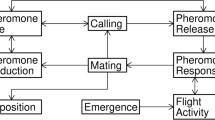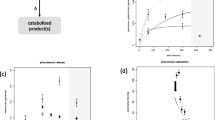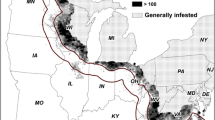Abstract
Models are presented to investigate the population dynamic behavior of a pest population with the release of pheromone for mating disruption. Three mechanisms of mating disruption are considered: (i) confusion of males, (ii) competition with female pheromone trails yielding false trail following, (iii) emigration of males prior to mating. In addition, several refinements to confusion are considered. Confusion and emigration of males were found to be very similar both quantitatively and dynamically; also, a combination of both mechanisms was very little more efficient than either one separately. False trail following is difficult to compare with the other two, since competition with wild females is involved and thus the total population size enters the equations. Density dependence of the action of pheromones results in some cases in which mating disruption cannot control the pest population. Similarly, aggregation of the pest population decreases the efficiency of the method unless the pheromone action is density independent. Delayed mating of females makes control easier, and may constitute one mechanism for mating disruption.
Similar content being viewed by others
References
Barclay, H. J. (1984) Pheromone trapping models for pest control: effects of mating patterns and immigration.Res. Popul. Ecol. 26: 303–311.
Barclay, H. J. (1992a) Modelling the effects of population aggregation on the efficiency of insect pest control.Res. Popul. Ecol. 34: 131–141.
Barclay, H. J. (1992b) Combining methods of insect pest control: partitioning mortality and predicting complementarity.Res. Popul. Ecol. 34: 91–107.
Barclay, H. J. and P. van den Driessche (1983) Pheromone trapping models for insect pest control.Res. Popul. Ecol. 25: 105–115.
Bartell, R. J. (1982) Mechanisms of communication disruption by pheromone in the control of Lepidoptera: a review.Physiol. Entomol. 7: 353–364.
Boswell, M. and G. P. Patil (1970) Chance mechanisms generating the negative binomial distributions. pp. 3–22In G. P. Patil (ed.)Random counts in models and structures. The Penn. State Univ. Press, University Park, Penn.
Carde, R. T. and A. K. Minks (1995) Control of moth pests by mating disruption: successes and constraints.Annu. Rev. Entomol. 40: 559–585.
Critchley, B. R., D. G. Campion, L. J. McVeigh, P. Hunter-Jones, D. R. Hall, A. Cork, B. F. Nesbitt, G. J. Marrs, A. R. Jutsum, M. M. Hosny, and E- S. A. Nasr (1983) Control of pink bollworm,Pectinophora gossypiella (Saunders) (Lepidoptera: Gelechiidae), in Egypt by mating disrption using an aerially applied microencapsulated pheromone formulation.Bull. Entomol. Res. 73: 289–299.
Ellis, P. E., L. C. Brimacombe, L. J. McVeigh and A. Dignan, (1980) Laboratory experiments on the disruption of mating in the Egyptian cotton leafwormSpodoptera littoralis (Biosduval) (Lepidoptera: Noctuidae) by excess of female pheromones.Bull. Entomol. Res. 70: 673–684.
Hendricks, D. E., C. T. Perez and R. J. Guerra (1982) Disruption ofHeliothis spp. mating behavior with chemical sex attractant components.Environ. Entomol. 11: 859–866.
Kiritani, K. and M. Kanoh (1984) Influence of delay in mating on the reproduction of the oriental tea tortrix,Homona magnanima diakonoff (Lepidoptera: Tortricidae), with reference to pheromone-based control.Prot. Ecol. 6: 137–144.
Lotka, A. (1956)Elements of mathematical biology. Dover, New York.
Nakasuji, F. and K. Fujita (1980) A population model to assess the effect of sex pheromones on population suppression.Appl. Entomol. Zool. 15: 27–35.
Niwa, C. G., G. E. Daterman, C. Sartwell and L. L. Sower (1988) Control ofRhyacionia zozana (Lepidoptera: Tortricidae) by mating disruption with synthetic sex pheromone.Environ. Entomol. 17: 593–595.
Palaniswamy, P., R. J. Ross, W. D. Seabrook, G. C. Lonergan, C. J. Wiesner, S. H. Tan and P. J. Silk (1982) Mating suppression of caged Spruce Budworm (Lepidoptera: Tortricidae) moths in different pheromone atmospheres and high population densities.J. Econ. Entomol. 75: 989–993.
Pielou, E. C. (1969)An introduction to mathematical ecology. J. Wiley, New York.
Sartwell, C., G. E. Daterman, D. L. Overhulser and L. L. Sower (1983) Mating disruption of western pine shoot borer (Lepidoptera: Tortricidae) with widely spaced releasers of synthetic pheromone.J. Econ. Entomol. 76: 1148–1151.
Schwalbe, C. P., E. C. Paszek, B. A. Bierl-Leonhardt and J. R. Plimmer (1983) Disruption of gypsy moth (Lepidotera: Lymantriidae) mating with disparlure.J. Econ. Entomol. 76: 841–844.
Sower, L. L., J. M. Wenz, D. L. Dahlsten and G. E. Daterman (1990) Field testing of pheromone disruption on preoutbreak populations of Douglas-fir tussock moth (Lepidoptera: Lymantriidae).J Econ. Entomol. 83: 1487–1491.
Van Steenwyk, R. A. and E. R. Oatman (1983) Mating disruption of tomato pinworm (Lepidopetra: Gelechiidae) as measured by pheromone trap, foliage, and fruit infestation.J. Econ. Entomol. 76: 80–84.
Author information
Authors and Affiliations
Rights and permissions
About this article
Cite this article
Barclay, H.J., Judd, G.J.R. Models for mating disruption by means of pheromone for insect pest control. Res Popul Ecol 37, 239–247 (1995). https://doi.org/10.1007/BF02515826
Received:
Accepted:
Issue Date:
DOI: https://doi.org/10.1007/BF02515826




